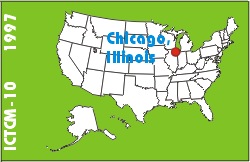
Electronic Proceedings of the Tenth Annual International Conference on Technology in Collegiate MathematicsChicago, Illinois, November 6-9, 1997Paper C031'Instant Insanity' meets Computer Algebra! |
Suda KunyosyingShepherd College Shepherdstown, WV 25443 USA skunyosy@shepherd.wvnet.edu list of all papers by this author |
| Click to access this paper: |
ABSTRACT
The major themes of a first course in discrete mathematics are generally logic and proofs, induction and recursion, combinatorics, algorithms and their analysis, and applications and modeling. The primary goals of this course are for students to understand the concepts of proofs and to improve their mathematical reasoning and problem solving skills.Solving a challenging problem often requires putting oneself in the right position to gain some crucial insight. Effective problem solvers always consider alternatives, experiment, conjecture, test, and analyze their results; they must possess an exploratory attitude.
Maple is a very powerful tool for doing mathematics and an efficient learning tool, if used properly. This presentation will demonstrate how to use Maple's symbolic computation and programming environment to explore topics in discrete mathematics such as logic, set, combinatorics, and graph theory, in order to develop an exploratory attitude in students. The paper will present worksheets and assignments that demonstrate how to use the computer algebra system, Maple, as a tool for students to further their understanding of concepts and applications in discrete mathematics , and not primarily as an exercise solver.
Among the examples presented will be several exploratory assignments which require students to think actively about the ideas inherent in the concepts of set , logic and proofs, and mathematical reasoning. One such example, focusing on the notion that 'One cannot teach a computer how to do something without learning it better oneself,' requires the students to write functions or procedures to implement abstract mathematical ideas in a concrete way, such as constructing a set of even or odd numbers, or testing the validity of a statement. These exercises really require the students to think about what the computer is doing when it is performing the instructions given it. As a result, they will begin to form a mental image of the ideas they are learning, and come to truly understand these ideas.
Further more, amidst the diversity of topics in discrete mathematics there is a unifying theme of algorithmic problem solving, that is solving problems by devising and analyzing algorithms which construct the solution. The paper will present examples of several interesting problems, such as the Instant Insanity Puzzle, and demonstrates how such techniques can be applied to solve them. The solution of the Instant Insanity Puzzle not only gives an interesting application of graph theory, but also illustrates the use of Maple's package Networks. In addition, several examples of computations and corresponding Maple codes that are specifically designed to shed light on familiar relations and reveal new patterns will be presented.
REFERENCES
1. Baxter, Nancy, Dubinsky, Ed, & Levin, Gary, Learning Discrete Mathematics with ISETL,
Springer-Verlag, New York, 1988.
2. Book, David L. Problems for Puzzlebusters, Enigmatics Press, Washington DC.
3. Chatrand, Gary, Graphs as Mathematical Models, Wadsworth International Group,
Belmont, California, 1977.
4. Jackson, Bradley W. & Thoro, Dmitri, Applied Combinatorics with Problem Solving,
Addison-Wesley Publishing Company, New York 1990.
Keyword(s): discrete mathematics, Maple
